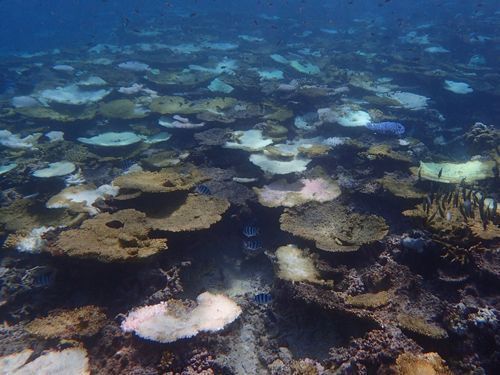Majority of Sekisei shoko coral reef dies with 97 % extremely severely bleached

Sekisei shoko coral reef covered with bleached coral colonies and dead coral.
November 10, 2016 Ryukyu Shimpo
The Ministry of the Environment’s Naha Office announced results from a survey on Sekisei shoko coral reef, one of the largest coral reef in Japan. The reef was being monitored for bleaching due to long-term high water temperatures this summer. The result was made public on November 9. The result shows that 97 percent of the coral reef is bleached, of which 56.7 percent is considered to be “a totally dead colony.” The ministry will conduct another survey in the same area by end of the year, warning “the result is anticipated to be extremely serious with more dead colonies.”
The survey was conducted over 35 points in the Sekisei shoko area between September 29 and October 4. The bleaching level was 89.6 percent during the first survey conducted between July 26 and August 17. The ministry concluded that most of the samples deemed “partially bleached/partially dead/totally faded” or “fully bleached” in late July faced worse damage due to the high-water temperature that lasted until early September. The ministry also conducted a similar survey over 36 points around the Keramashoto National park area between October 6 and 25. The average rate of bleaching is 15.2 percent, of which 1.9 percent is completely dead.
(English translation by T&CT and Sayaka Sakuma)
Previous Article:Fisherman Yamashiro: Destroying the forests will kill the ocean
Next Article:East Asia Publishers Conference in Okinawa addresses reviving an East Asian reading community
[Similar Articles]
- Japan’s largest coral reef has not recovered from previous years’ wide-scale bleaching
- 80 percent of Ishigaki Island’s coral reefs becoming bleached
- Survey shows coral in Oura is “healthy” with some bleaching
- MIyako Island coral reef dies due to high water temperatures
- Coral bleaching confirmed at Kunigami for the first time since 1998
 Webcam(Kokusai Street)
Webcam(Kokusai Street)


